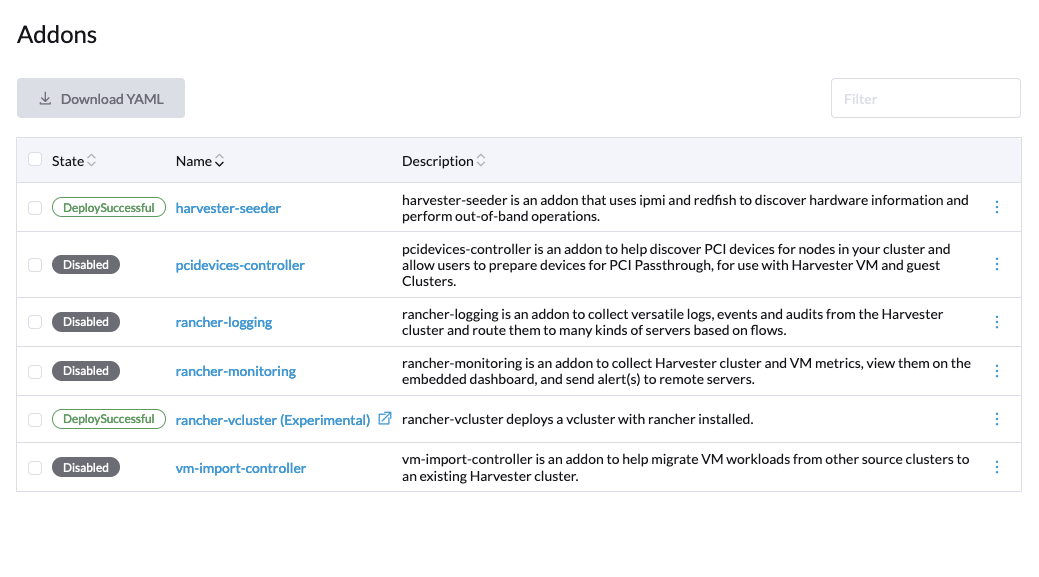VM Import
Available as of v1.1.0
With the vm-import-controller addon users can import their virtual machines from VMware and OpenStack into Harvester.
To use the VM import feature, users need to enable the vm-import-controller addon.

By default, vm-import-controller leverages ephemeral storage, which is mounted from /var/lib/kubelet.
During the migration, a large VM's node could run out of space on this mount, resulting in subsequent scheduling failures.
To avoid this, users are advised to enable PVC-backed storage and customize the amount of storage needed. According to the best practice, the PVC size should be twice the size of the largest VM being migrated. This is essential as the PVC is used as scratch space to download the VM, and convert the disks into raw image files.

vm-import-controller
Currently, the following source providers are supported:
- VMware
- OpenStack
API
The vm-import-controller introduces two CRDs.
Sources
Sources allow users to define valid source clusters.
For example:
apiVersion: migration.harvesterhci.io/v1beta1
kind: VmwareSource
metadata:
name: vcsim
namespace: default
spec:
endpoint: "https://vscim/sdk"
dc: "DCO"
credentials:
name: vsphere-credentials
namespace: default
The secret contains the credentials for the vCenter endpoint:
apiVersion: v1
kind: Secret
metadata:
name: vsphere-credentials
namespace: default
stringData:
"username": "user"
"password": "password"
As part of the reconciliation process, the controller will log into vCenter and verify whether the dc specified in the source spec is valid.
Once this check is passed, the source is marked as ready and can be used for VM migrations.
$ kubectl get vmwaresource.migration
NAME STATUS
vcsim clusterReady
For OpenStack-based source clusters, an example definition is as follows:
apiVersion: migration.harvesterhci.io/v1beta1
kind: OpenstackSource
metadata:
name: devstack
namespace: default
spec:
endpoint: "https://devstack/identity"
region: "RegionOne"
credentials:
name: devstack-credentials
namespace: default
The secret contains the credentials for the OpenStack endpoint:
apiVersion: v1
kind: Secret
metadata:
name: devstack-credentials
namespace: default
stringData:
"username": "user"
"password": "password"
"project_name": "admin"
"domain_name": "default"
"ca_cert": "pem-encoded-ca-cert"
As part of the reconciliation process, the controller attempts to list VMs in the project and marks the source as ready.
$ kubectl get openstacksource.migration
NAME STATUS
devstack clusterReady
VirtualMachineImport
The VirtualMachineImport CRD provides a way for users to define a source VM and map to the actual source cluster to perform VM export/import.
A sample VirtualMachineImport looks like this:
apiVersion: migration.harvesterhci.io/v1beta1
kind: VirtualMachineImport
metadata:
name: alpine-export-test
namespace: default
spec:
virtualMachineName: "alpine-export-test"
folder: "Discovered VM"
networkMapping:
- sourceNetwork: "dvSwitch 1"
destinationNetwork: "default/vlan1"
- sourceNetwork: "dvSwitch 2"
destinationNetwork: "default/vlan2"
sourceCluster:
name: vcsim
namespace: default
kind: VmwareSource
apiVersion: migration.harvesterhci.io/v1beta1
This will trigger the controller to export the VM named "alpine-export-test" on the VMware source cluster to be exported, processed and recreated into the Harvester cluster.
This can take a while based on the size of the virtual machine, but users should see VirtualMachineImages created for each disk in the defined virtual machine.
If the source virtual machine is placed in a folder, you can specify the folder name in the optional folder field.
The list of items in networkMapping will define how the source network interfaces are mapped to the Harvester Networks.
If a match is not found, each unmatched network interface is attached to the default managementNetwork.
The storageClass field specifies the StorageClass to be used for images and provisioning persistent volumes during the import process. If not specified, the default StorageClass will be used.
Once the virtual machine has been imported successfully, the object will reflect the status:
$ kubectl get virtualmachineimport.migration
NAME STATUS
alpine-export-test virtualMachineRunning
openstack-cirros-test virtualMachineRunning
Similarly, users can define a VirtualMachineImport for an OpenStack source as well:
apiVersion: migration.harvesterhci.io/v1beta1
kind: VirtualMachineImport
metadata:
name: openstack-demo
namespace: default
spec:
virtualMachineName: "openstack-demo" #Name or UUID for instance
networkMapping:
- sourceNetwork: "shared"
destinationNetwork: "default/vlan1"
- sourceNetwork: "public"
destinationNetwork: "default/vlan2"
storageClass: "my-storage-class"
sourceCluster:
name: devstack
namespace: default
kind: OpenstackSource
apiVersion: migration.harvesterhci.io/v1beta1
OpenStack allows users to have multiple instances with the same name. In such a scenario, users are advised to use the Instance ID. The reconciliation logic tries to perform a name-to-ID lookup when a name is used.
Known issues
Source virtual machine name is not RFC1123 compliant: When creating a virtual machine object, the vm-import-controller add-on uses the name of the source virtual machine, which may not meet the Kubernetes object naming criteria. You may need to rename the source virtual machine to allow successful completion of the import.
Virtual machine image name is too long: The vm-import-controller add-on labels each imported disk using the format
vm-import-$VMname-$DiskName. If a label exceeds 63 characters, you will see the following error message in the vm-import-controller logs:harvester-vm-import-controller-5698cd57c4-zw9l5 time="2024-08-30T19:20:34Z" level=error msg="error syncing 'default/mike-mr-tumbleweed-test': handler virtualmachine-import-job-change: error creating vmi: VirtualMachineImage.harvesterhci.io \"image-z
nqsp\" is invalid: metadata.labels: Invalid value: \"vm-import-mike-mr-tumbleweed-test-mike-mr-tumbleweed-test-default-disk-0.img\": must be no more than 63 characters, requeuing"You may need to rename the source virtual machine to allow successful completion of the import.